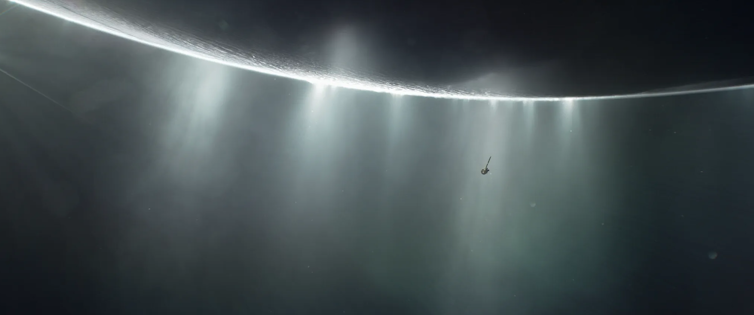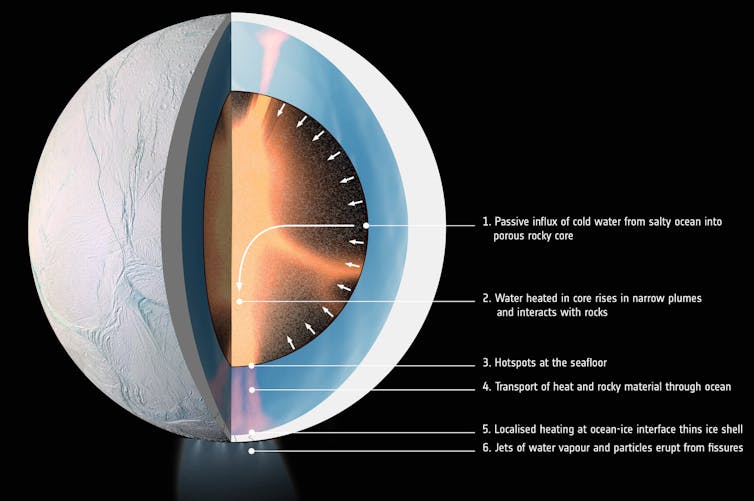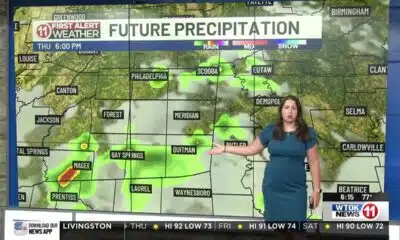
NASA/JPL-Caltech, CC BY-SA
Fabian Klenner, University of Washington
Saturn has 146 confirmed moons – more than any other planet in the solar system – but one called Enceladus stands out. It appears to have the ingredients for life.
From 2004 to 2017, Cassini – a joint mission between NASA, the European Space Agency and the Italian Space Agency – investigated Saturn, its rings and moons. Cassini delivered spectacular findings. Enceladus, only 313 miles (504 kilometers) in diameter, harbors a liquid water ocean beneath its icy crust that spans the entire moon.
Geysers at the moon’s south pole shoot gas and ice grains formed from the ocean water into space.
Though the Cassini engineers didn’t anticipate analyzing ice grains that Enceladus was actively emitting, they did pack a dust analyzer on the spacecraft. This instrument measured the emitted ice grains individually and told researchers about the composition of the subsurface ocean.
As a planetary scientist and astrobiologist who studies ice grains from Enceladus, I’m interested in whether there is life on this or other icy moons. I also want to understand how scientists like me could detect it.
Ingredients for life
Just like Earth’s oceans, Enceladus’ ocean contains salt, most of which is sodium chloride, commonly known as table salt. The ocean also contains various carbon-based compounds, and it has a process called tidal heating that generates energy within the moon. Liquid water, carbon-based chemistry and energy are all key ingredients for life.
In 2023, I and others scientists found phosphate, another life-supporting compound, in ice grains originating from Enceladus’ ocean. Phosphate, a form of phosphorus, is vital for all life on Earth. It is part of DNA, cell membranes and bones. This was the first time that scientists detected this compound in an extraterrestrial water ocean.
Enceladus’ rocky core likely interacts with the water ocean through hydrothermal vents. These hot, geyserlike structures protrude from the ocean floor. Scientists predict that a similar setting may have been the birthplace of life on Earth.

Surface: NASA/JPL-Caltech/Space Science Institute; interior: LPG-CNRS/U. Nantes/U. Angers. Graphic composition: ESA
Detecting potential life
As of now, nobody has ever detected life beyond Earth. But scientists agree that Enceladus is a very promising place to look for life. So, how do we go about looking?
In a paper published in March 2024, my colleagues and I conducted a laboratory test that simulated whether dust analyzer instruments on spacecraft could detect and identify traces of life in the emitted ice grains.
To simulate the detection of ice grains as dust analyzers in space record them, we used a laboratory setup on Earth. Using this setup, we injected a tiny water beam that contained bacterial cells into a vacuum, where the beam disintegrated into droplets. Each droplet contained, in theory, one bacterial cell.
Then, we shot a laser at the individual droplets, which created charged ions from the water and the cell compounds. We measured the charged ions using a technique called mass spectrometry. These measurements helped us predict what dust analyzer instruments on a spacecraft should find if they encountered a bacterial cell contained in an ice grain.
We found these instruments would do a good job identifying cellular material. Instruments designed to analyze single ice grains should be able to identify bacterial cells, even if there is only 0.01% of the constituents of a single cell in an ice grain from an Enceladus-like geyser.
The analyzers could pick up a number of potential signatures from cellular material, including amino acids and fatty acids. Detected amino acids represent either fragments of the cell’s proteins or metabolites, which are small molecules participating in chemical reactions within the cell. Fatty acids are fragments of lipids that make up the cell’s membranes.
In our experiments, we used a bacteria named Sphingopyxis alaskensis. Cells of this culture are extremely tiny – the same size as cells that might be able to fit into ice grains emitted from Enceladus. In addition to their small size, these cells like cold environments, and they need only a few nutrients to survive and grow, similar to how life adapted to the conditions in Enceladus’ ocean would probably be.
The specific dust analyzer on Cassini didn’t have the analytical capabilities to identify cellular material in the ice grains. However, scientists are already designing instruments with much greater capabilities for potential future Enceladus missions. Our experimental results will inform the planning and design of these instruments.
Future missions
Enceladus is one of the main targets for future missions from NASA and the European Space Agency. In 2022, NASA announced that a mission to Enceladus had the second-highest priority as they picked their next big missions – a Uranus mission had the highest priority.
The European agency recently announced that Enceladus is the top target for its next big mission. This mission would likely include a highly capable dust analyzer for ice grain analysis.
Enceladus isn’t the only moon with a liquid water ocean. Jupiter’s moon Europa also has an ocean that spans the entire moon underneath its icy crust. Ice grains on Europa float up above the surface, and some scientists think Europa may even have geysers like Enceladus that shoot grains into space. Our research will also help study ice grains from Europa.
NASA’s Europa Clipper mission will visit Europa in the coming years. Clipper is scheduled to launch in October 2024 and arrive at Jupiter in April 2030. One of the two mass spectrometers on the spacecraft, the SUrface Dust Analyzer, is designed for single ice grain analysis.

NASA/CU Boulder/Glenn Asakawa
Our study demonstrates that this instrument will be able to find even tiny fractions of a bacterial cell, if present in only a few emitted ice grains.
With these space agencies’ near-future plans and the results of our study, the prospects of upcoming space missions visiting Enceladus or Europa are incredibly exciting. We now know that with current and future instrumentation, scientists should be able to find out whether there is life on any of these moons.
Fabian Klenner, Postdoctoral Scholar in Earth and Space Sciences, University of Washington
This article is republished from The Conversation under a Creative Commons license. Read the original article.

















































